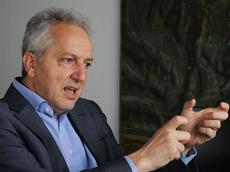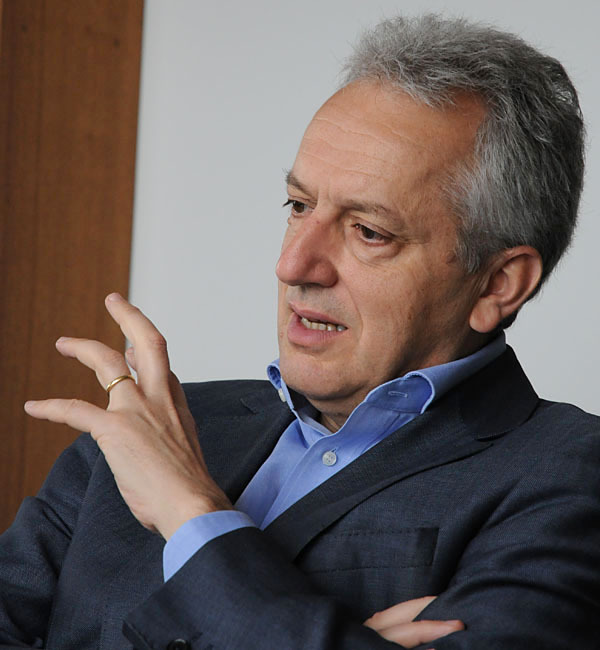Great potential and many unknowns
The Werner Siemens Foundation has donated CHF 10 million to ETH Zurich’s deep geothermal energy initiative in support of its intention to set up the first of the two planned professorships in the field deep geothermics. In an interview with ETH Life, Executive Board Delegate for deep geothermics Professor Domenico Giardini talks about the opportunities, risks and possibilities involved in exploiting this form of energy in Switzerland and what the first professorship of geoenergy needs to achieve.

ETH Life: The donation from the Siemens
Foundation enables ETH Zurich to set up a new chair to head research in deep
geothermal energy. Where should focus lie?
Domenico Giardini: Our
initial focus will be to research whether or not deep geothermics can be
implemented in Switzerland. At present, we can’t say for sure whether we’ll be
able to generate five, ten or zero per cent of our electricity and energy with
the aid of deep geothermics by 2050. We won’t know the answer until we research
the field thoroughly.
The new professorship is incorporated in the geosciences.
What questions is it looking to answer?
The
professorship should examine the geological environment at depths where heat can
be obtained – in other words, observing whether there is any water three to
five kilometres beneath the Earth’s surface and identifying the nature of the
bedrock. In order to determine where deep geothermics might be deployed, we
need to understand the geological landscape as well as define the best extracting
methods. We also want to find out if this heat can be used to generate energy.
If we want to get the most out of deep geothermics, it is important that we choose
the right techniques/procedures.
Is ETH Zurich betting on the right horse in
pushing deep geothermic research?
Yes. The
Swiss government, cantons, communities and industry are extremely interested in
deep geothermics. Industry knows only too well that it won’t get anywhere
without research or a better understanding of technology. The Swiss government has
set aside another CHF 202 million for energy research for 2013-2016. One of the
fields funded is deep geothermics, indicating that the interest in the topic is
fundamental and important for society as a whole. I am especially pleased that
donors have also taken this message on board and are investing in the development
of deep geothermics. The Werner Siemens Foundation also recognised that this
field requires research and development, and that this will directly benefit society.
Nonetheless, a lot is still up in the air.
Isn’t ETH Zurich running the risk of having to close the deep geothermics file
in ten years?
No. In ten
years, we probably won’t be producing much electricity with deep geothermics. There
will come a phase when the technology will remain in an experimental stage and
we’ll have to subsidise electricity from deep geothermics. However, it’s the
same story with all new renewable energies. It will take time and new research
breakthroughs before deep geothermics can be successful as a technology. So, if
the question is whether deep geothermics will still be of interest to ETH
Zurich in ten years’ time, the answer is certainly positive - it will be even
more interesting than it is today.
In Basel the acceptance of deep geothermal
energy suffered a major setback after an earthquake was triggered by deep
drilling. How can you convince the general population that exploring and
developing geothermics is of value?
People quite
rightly have a primal fear of earthquakes. In Basel the methods used that were
claimed to entail virtually no risk. Naturally, the public didn’t understand
why a supposedly “risk-free” technology caused an earthquake. Going forward we
have to proceed with extreme caution because we can’t afford to make any big
mistakes, neither in communication nor in technology.
The biggest question seems to be whether there
is any potential for deep geothermics in Switzerland. How great is it in your
opinion?
Deep
geothermics has immense potential as the amount of thermal energy is really
quite vast. The depths of our planet are hot, as we know from tunnel
constructions like the Gotthard or Neat tunnels. This thermal energy arises
through the breakdown of radioactive elements and through the energy that
remained trapped inside the Earth after it was formed. If you drill into the
depths, the temperature rises twenty to thirty degrees per kilometre.
Is deep geothermics really the inexhaustible
energy source it is made out to be?
Yes, it is.
If you cool a deep rock volume by using the heat, it will take a long time for
it to warm up again. However, the bedrock consists of many cubic kilometres
that we can’t use up, even in the distant future. In that sense, deep
geothermics is truly inexhaustible.
What happens to the plant if the drilled rock
volume has cooled?
The idea is
to drill a new rock volume within the premises of the same plant; for example, on
the side or further down. The volume is so gigantic that it isn’t a resource
problem. The challenge is to install the first successful plant.
The Swiss Federal Office for Energy talks of
ten to fifteen per cent of electricity from deep geothermics and a dozen plants
by 2050.
Currently,
the proportion of deep geothermics in the production of electricity is zero per
cent, which is why an increase of one per cent will already be an advantage.
However, this wouldn’t solve our energy problems. If we see that the first
drillings are heading in the right direction, possibilities will arise to
install a sizeable amount by the year 2050, with an output of one
gigawatt.
What is your personal opinion on deep
geothermics? What proportion of the energy mix will it generate?
The aim is
to use it to produce at least five to ten per cent of Switzerland’s electricity
by 2050. Otherwise, the technology won’t be worth it. Deep geothermics is still
too expensive today. We may not obtain as much energy as we hope in the first
phase, but will press to make a breakthrough in the future. ETH Zurich is now
doing its utmost to research and promote the technology, devoting two
professorships to the field and encouraging industrial collaborations.
Domenico Giardini is a professor of seismology and geodynamics in the Department of Earth Sciences at ETH Zurich, and the Executive Board’s delegate for deep geothermics. From 1997 to the end of 2011, he was the director of the Swiss Seismological Service (SED).








READER COMMENTS